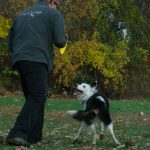Reading the disc is a skill that astute dogs and humans pick up rather quickly. The float, the spin Spins and Twists are tricks where the dog spins 360 degrees in a clockwise or counter clockwise fashion. Spin is clockwise and Twist is counter clockwise so it is important to have a... More, and the speed can reliably be gauged and predicted after several reps. Of course this changes with wind, disc choice, and throwing ability but, generally speaking, the flight path of a disc is easily predicted.
Spins and Twists are tricks where the dog spins 360 degrees in a clockwise or counter clockwise fashion. Spin is clockwise and Twist is counter clockwise so it is important to have a... More, and the speed can reliably be gauged and predicted after several reps. Of course this changes with wind, disc choice, and throwing ability but, generally speaking, the flight path of a disc is easily predicted.


Responses